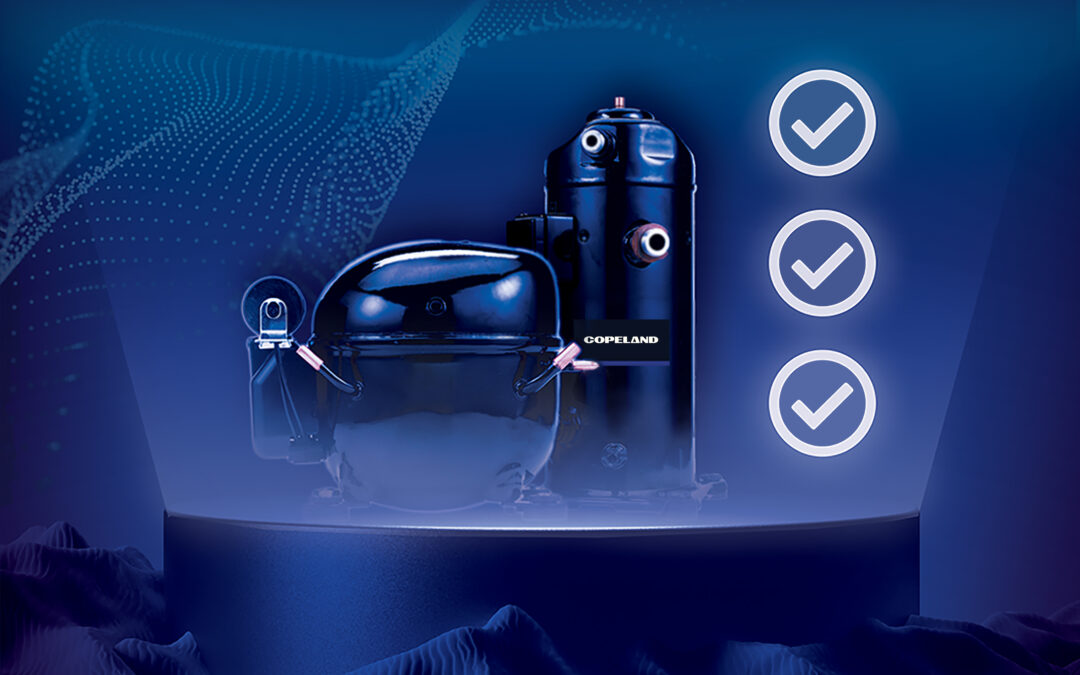*On June 1, 2023 Emerson’s Climate Technologies business became a new standalone company – Copeland. Though our name has changed, we are building on more than a century of HVACR innovation and industry leadership, and Copeland continues to offer the same products, industry stewardship, and learning opportunities you’ve grown to trust. Information found on this webpage posted before June 1, 2023 may contain our old name or branding, but you can be at ease knowing it was created with the knowledge and expertise of Copeland.

Implement variable fan speed control
Most centralized direct expansion (DX) systems are designed for peak summer heat and use mechanical head pressure control valves to maintain fixed pressure in the condenser equivalent to 105 °F condensing. In cooler seasonal conditions, this approach creates a considerably oversized condenser, where a substantial portion of the condenser volume is being used to store liquid in order to build pressure up to 105 °F minimum condensing.
A potential fix to remedying this situation is to remove the mechanical head pressure control valve and install a variable-frequency drive (VFD) to control the condenser fan’s speed. Instead of operating with a minimum fixed head pressure, this strategy provides variable head pressure throughout the year. This allows the system to operate with less refrigerant by removing the need to have a “winter charge” to flood the condenser in low ambient conditions.
Note: For operators in northern climates with sustained periods of sub-zero temperatures (-20° F to -30° F), utilizing a flooded head pressure approach may be necessary to keep systems running during those periods.
If you discover that a condenser needs to be replaced, an additional charge reduction can be achieved from implementing a split-condenser design. The approach effectively helps to maintain system pressure by cutting the condenser surface area in half as ambient temperatures drop, creating a net reduction in condenser surface area, which further lowers the system charge. In summer months, when the condenser utilizes every inch of its surface area, excess liquid refrigerant can be stored in a large receiver tank designed to hold both the summer and winter charges. Consider also using a low-condensing approach in combination with an efficient liquid subcooling strategy to achieve additional charge reductions while maximizing system performance, energy efficiency and reliability.
Adopt a looped piping strategy
In conventional centralized DX systems, individual liquid refrigerant and return suction lines are fed from the refrigeration rack to each case in a supermarket — which requires a large refrigerant charge to support the full load of all cases. An alternative to this approach would be to adopt a looped piping strategy by running fewer large lines to designated sections of the store, from which smaller lines branch off to individual cases. For example, instead of running 30 long lines to individual cases, four to five line loops would support key store sections — with much smaller lines branched off these loops to feed the individual cases. In doing so, store operators can reduce piping, lower leak rates, and achieve a significant reduction in refrigerant charge.
Disconnect and re-distribute remote refrigeration loads
Another common centralized DX refrigeration challenge is to provide adequate refrigeration for cases that are located farthest from the machine room. Unless the system is operating perfectly, the liquid refrigerant traveling through those long liquid lines can develop flash gas bubbles by the time it reaches these distant cases. This results in a variety of issues, which can ultimately increase the amount of refrigerant needed and impact case temperatures.
One potential solution is to disconnect these remote cases from their suction group and install segments of distributed equipment to handle them individually. This reduces the refrigerant charge in the centralized DX system and allows it to operate more efficiently. The Copeland™ digital outdoor refrigeration unit, X-Line Series is ideal for servicing these remote cases or supporting new refrigeration requirements, such as walk-in coolers for click-and-collect fulfillment. In addition, the Copeland indoor modular solution provides flexible options for spot merchandizing cases, which could also be disconnected from a DX system.
Transition to distributed architectures
The prospect of large-scale leak events is always a possibility in large DX centralized systems, which can often be charged with up to 4,000 pounds of refrigerant. If even half of that charge were to be emitted in a catastrophic leak, operators would face potential environmental penalties and excessive refrigerant replacement costs. But this centralized approach is no longer the only option for large-supermarket refrigeration. In their place is an emerging variety of distributed architectures designed to lower refrigerant charges, deliver improved energy efficiencies, and operate using lower-GWP refrigerants.
Distributed architectures that utilize Copeland scroll compression technology can deliver significant system efficiencies, particularly when using a low-pressure refrigerant like R-513A. For example, Emerson’s distributed scroll booster architecture is designed to overcome common low-temperature system challenges and leverage R-513A’s low pressure and high efficiency to provide:
-
- Lower discharge temperatures and compression ratios: 1.9:1 at -10 °F saturated suction temperature (SST) and 20 °F saturated discharge temperature (SDT)
- Reduced compressor strain and related maintenance issues
- Increased overall system efficiency and lifespan
- Reduced stress on pipes and fittings, which lowers the potential for leaks
All the strategies discussed herein will not only help to lower your refrigerant charge but also deliver a variety of system efficiency and reliability benefits.

Address Efficiency Mandates with Compression Technologies
Strategies for complying with DOE and ENERGY STAR® in self-contained and remote condensing units...

EPA SNAP Rule 26 Approves, Modifies Use Conditions for A2L and A3 Refrigerants
On May 28, the Environmental Protection Agency (EPA) pre-published its Significant New...

Refrigerant Transition Highlights the Importance of Leak Detection
*On June 1, 2023 Emerson’s Climate Technologies business became a new standalone company –...
